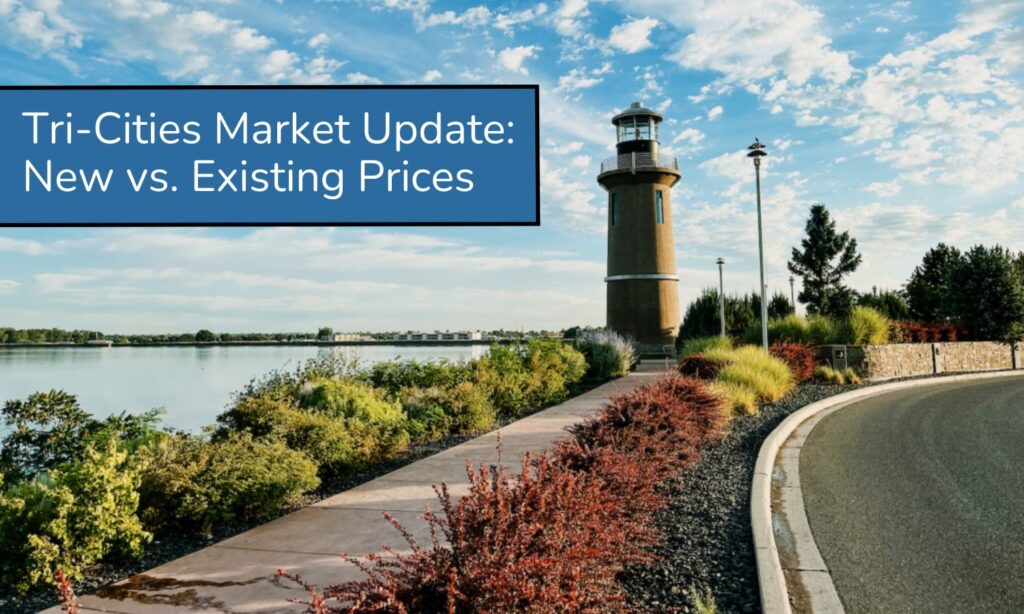Pricing trends in real estate can reveal a lot about market conditions, particularly when comparing new construction with existing homes. Whether you’re buying or selling, understanding how listing and selling prices differ between these two categories can help you make informed decisions. This report breaks down price trends across the Tri-Cities, examining both listing and final sales prices.
How Do Listing and Selling Prices Compare Between New and Existing Construction?
Looking at the data across West Richland, Richland, Pasco, and Kennewick, we can identify clear trends in price differences between new and existing homes.
West Richland
- Existing Construction (past 12 months)
- Average Listing Price: $555,888
- Average Final Price: $545,512
- Price Difference: 1.9% drop from listing to final price
Richland
- Existing Construction (past 12 months)
- Average Listing Price: $523,023
- Average Final Price: $509,607
- Price Difference: 2.6% drop
Pasco
- Existing Construction (past 12 months)
- Average Listing Price: $488,289
- Average Final Price: $477,202
- Price Difference: 2.3% drop
Kennewick
- Existing Construction (past 12 months)
- Average Listing Price: $500,899
- Average Final Price: $487,154
- Price Difference: 2.7% drop
Key Takeaways
- Across all cities, existing home prices see a slight drop between listing and final sales price (1.9%–2.7%).
- West Richland sellers are seeing the smallest price reduction, suggesting strong demand.
- Kennewick and Richland have slightly larger price drops, indicating more room for negotiation.
How Does This Compare to New Construction?
While the provided data focuses primarily on existing construction, broader market trends indicate that new construction homes typically list and sell at a premium compared to existing homes. Here’s why:
- New construction homes tend to have fewer price reductions.
- Builders often price homes based on market demand, and price adjustments are less common.
- Customization options can also increase the final price.
- Higher price per square foot.
- New homes often feature modern designs, energy efficiency, and premium materials, raising the price per square foot compared to older homes.
- Limited inventory can drive up demand.
- The Tri-Cities area has seen low inventory for new construction, making these homes more competitive.
- Buyers may pay full price or more.
- Unlike existing homes, where sellers negotiate based on comparable sales, builders often hold firm on pricing.
In contrast, existing homes often see price reductions because:
- Sellers may need to adjust pricing based on market feedback.
- Home condition, age, and location impact negotiations more significantly.
What This Means for Buyers & Sellers
For buyers:
- New construction is more predictable in pricing but comes at a premium. Expect fewer price cuts and potentially higher costs for customization.
- Existing homes offer more negotiation power and potential savings, particularly in Kennewick and Richland.
For sellers:
- If you’re selling an existing home, price competitively to attract buyers in a market where final prices are slightly lower than listing prices.
- If you own a newer home, highlight modern upgrades and move-in readiness to compete with new construction.
Final Thoughts
Across the Tri-Cities, existing homes consistently sell for slightly less than their listing price, while new construction homes maintain stronger pricing due to limited supply and demand for modern features.
West Richland stands out as a strong seller’s market, while Pasco and Kennewick offer better negotiation opportunities for buyers. Whether you’re considering new or existing construction, knowing these trends can help you make the best decision.
For personalized advice on buying or selling, contact ryan@kenmoreteam.com or call 509.987.4544.

